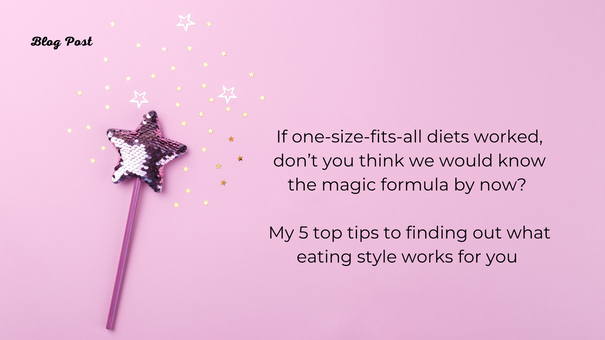ARTICLE Categories
All
|
If one-size-fits-all diets worked, don’t you think we would know the magic formula by now?1/24/2023 My 5 top tips to finding out what eating style works for youHands up if you’ve seen or heard something about a magic formula that results in weight loss, more energy, miracle reduction in x, y, or z symptoms and all in record time. Maybe you saw something on the television, read it in a magazine or even witnessed a friend being transformed in front of your own eyes.
Now hands up if you tried it yourself. You bought the book/programme and lined yourself up to follow the same plan. If I might hazard a guess, it didn’t have quite the same miraculous effect. What do you think happened? Please don’t tell me that you blamed yourself. If you did, remember this: If one-size-fits-all diets worked, don’t you think we would know the magic formula by now? Finding out what works for you and your lifestyle is the key to it all and in this article, I will give you five ways to explore what that is.
Please note that these tips do not provide any nutritional advice. If you are looking for personalised recommendations to support a specific health issue, you should contact a nutrition or health professional. I offer free (no-obligation) introductory calls if you wish to explore this avenue further. You can book for an adult here or a child here. You know yourself much more than you think you do, so here are my 5 top tips to help you discover what works for you. 1. In your experience, in the past, what has worked, not worked, or worked but not been sustainable? Get a piece of paper and divide it into three columns. Think back to what has worked for you in the past. Was there a time in your life where you were eating a certain way or following certain habits and you felt amazing? Or how about things that you tried but realised didn’t suit you? Please don’t include those times where you crashed dieted to fit into a certain outfit for a certain event. Use the three columns to divide your recollections into things that worked, things that didn’t and finally things that you thought worked but were not sustainable long term. Remember that the things that worked or didn’t, could be a patchwork of things from different periods in your life. At university it may have been the sport, during your first job it could have been enjoying a loaded coffee and muffin every day on your way in and more recently it could be that you tried apple cider vinegar in water before a meal, but you hate the taste, and it gave you heartburn. Don’t just do this exercise in one go, keep coming back to it and adding to the recollections. Review what you have written. Which things in the ‘didn’t work’ column do you find yourself still doing now and that you probably could set to one side? Which in the ‘did work’ had you forgotten about and think that you could reincorporate into your daily life. Finally, are there any in the ‘worked but not sustainable’ column that you could adapt so that they do work for you long term? 2. Keep a record. I work with a lot of clients (adults and children) who suspect that there are foods that don’t suit them. One of the first things I do is ask them to keep a food and symptom diary so that we can, perhaps, identify patterns or triggers. I have a free tool for recording this available here. If you are trying to find out which ways of eating suit you, then you would also benefit from recording what you eat, but instead of writing down what symptoms occur, although you can include those too, you would write down how you felt after a meal. After a baked potato, did you feel great and were able to power through to the next meal without snacking or did you have an energy slump after about 30 minutes and want a nap? If you have breakfast, does that sustain you or does it open the door to feeling hungry for the rest of the morning? Can you identify any foods that bizarrely make you feel hungrier rather than satisfy you? What else have you spotted that give you clues? To find out how we should eat, we need to be an observer of how we feel. Consider it doing your own scientific study. Recording isn’t for everyone, however. If you find yourself spending a bit too much time recording things, then this tip isn’t for you, and you would do better letting it go. We can be too caught up in the detail, the idea is to see the bigger picture and relax about the whole. 3. Use your imagination, but be realistic Now that you’ve sifted through your recollections it’s time to use your imagination. If you could design a way of eating based on what you know about yourself, which fits with your values and is sustainable forever, what would it look like? This tip is about not only choosing foods that suit you in terms of nutrition, but also suit your lifestyle and budget. Whichever way of eating suits you best, be it omnivore, low carb, plant-based or other, must be practical. Otherwise, with all the will in the world, you won’t keep it up. Consistency is the key. Consistency in your eating habits, body movement and lifestyle choices. So, if you could design your perfect nutrition and lifestyle habits, what do you think they would be? Once you have that vision in your mind start implementing them. Don’t go too fast though! It’s easy to do all and then nothing. Introduce one thing at a time, when you feel as if it is integrated into your life, then move on to the next. 4. Don’t get hung up on the hype. This past month has seen the publication of multiple articles predicting this year’s superfoods. Don’t get me wrong, there are some foods that are absolute powerhouses of nutrition, but it doesn’t mean that that you will be under-nourished if you don’t have them. You could go out and spend a fortune on the new wonder food, but there is probably a more local, cost-effective food that will do just as well and that you could eat more regularly. A diet that suits you is one that suits every aspect of your life. 5. What to do if you DO want to follow a certain diet but your body rebels? Ethical, cultural, or religious reasons can make you want to eat a certain way, even if you can sense that it isn’t the best way to eat for you. My advice in these cases is to take it slow and steady. Research has shown that our gut microbiome adapts itself to our diets. Whatever you are eating on a regular basis is reflected in the bacterium types in your gut. Changing your diet suddenly can cause digestive issues simply because there aren’t the right gut bacteria to digest and process the new foods. I always tell my clients to slowly introduce the new way of eating at a pace that allows the new microbiota population to grow at a similar pace. At the right time you may reach a tipping point where you can eat the new diet with no problems. If you are having continued issues with adapting your diet, then it may be best to get the support of a nutrition or health practitioner. So, to summarise my tips:
Read more, here are some of my previous blogs that you may find helpful:
To easily keep up with my articles, masterclasses, ebooks and online programmes and receive exclusive access to early bird offers, sign-up to my newsletter. My current newsletter features an early bird offer for my brand new online, self-guided course ‘Unleash the Change. Discover the habits and barriers hampering your efforts’. Sign-up to my newsletter now to benefit. Interested in what I do and who I am? Go to my website: www.jessicafonteneaunutrition.com
0 Comments
Leave a Reply. |
AuthorI’m Jessica Fonteneau, I’m the eczema specialist and I help people Escape from the Eczema trap. Archives
April 2024
Catégories
All
|


 RSS Feed
RSS Feed